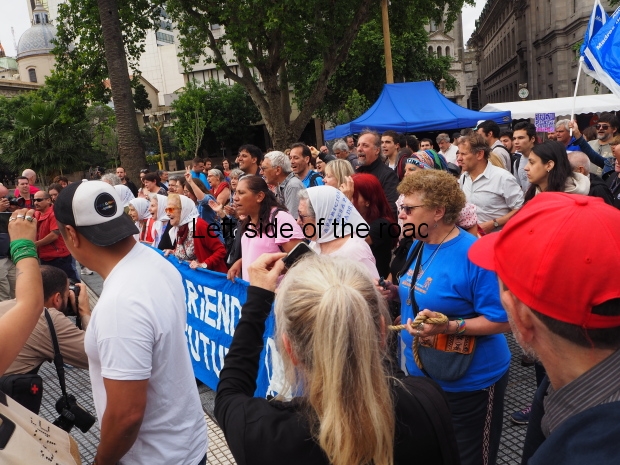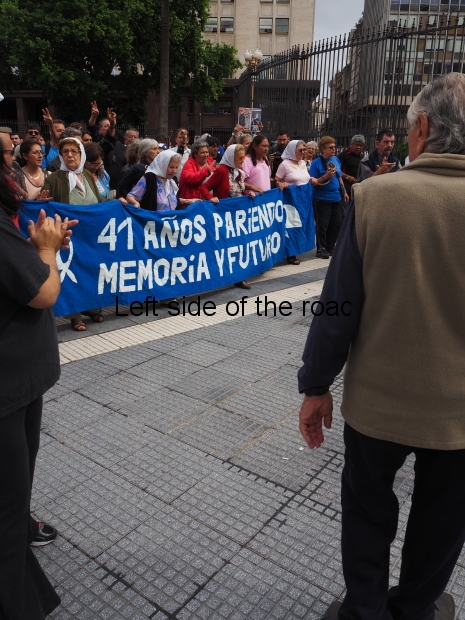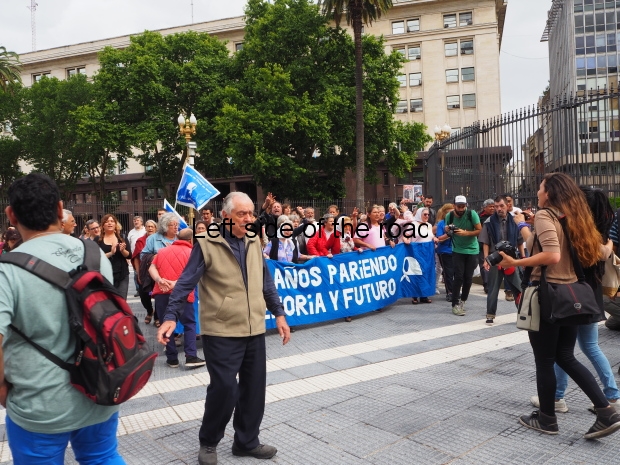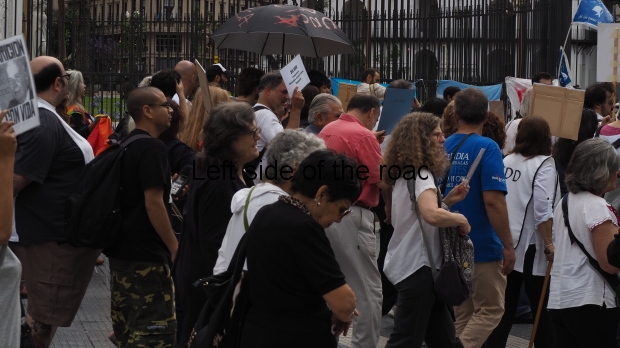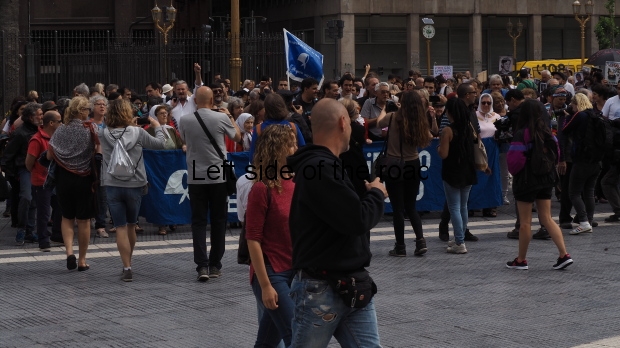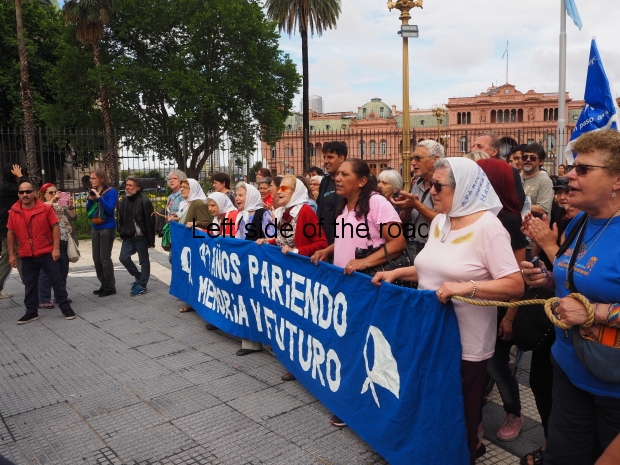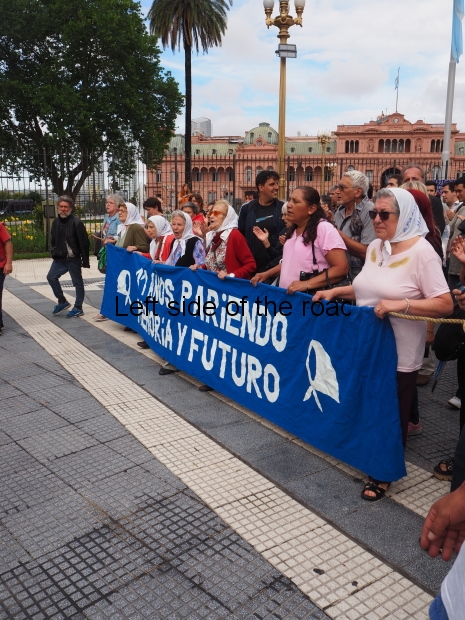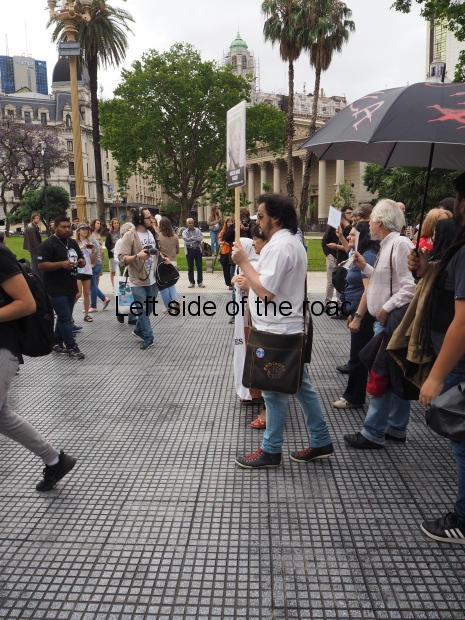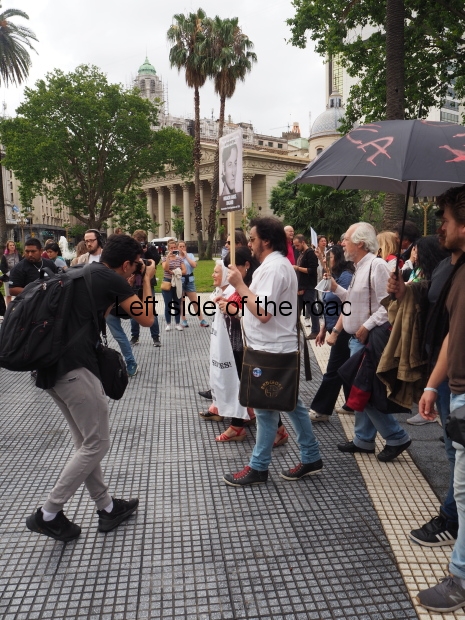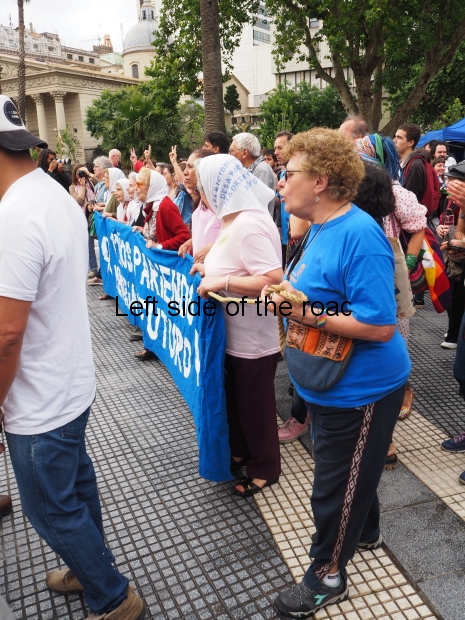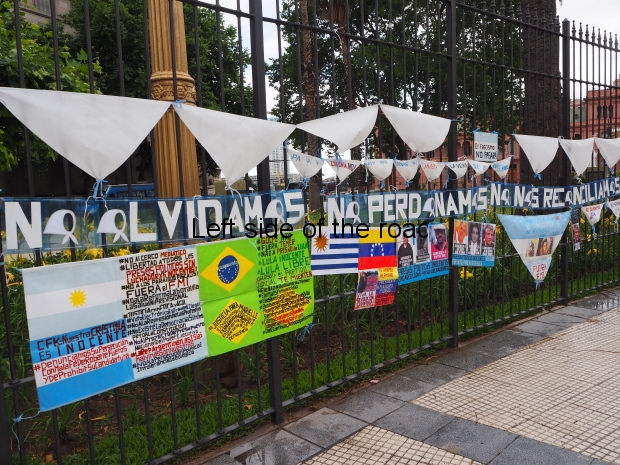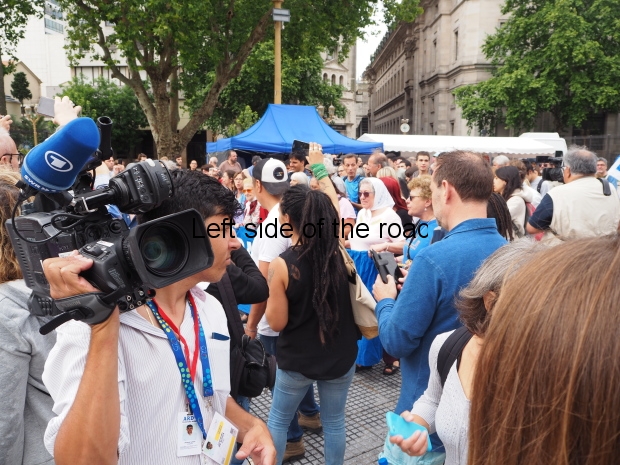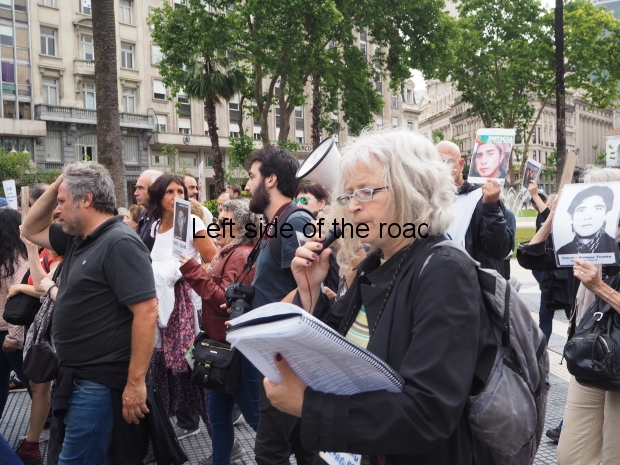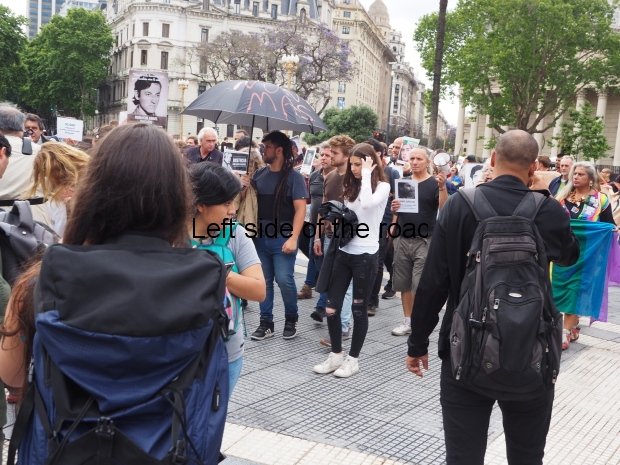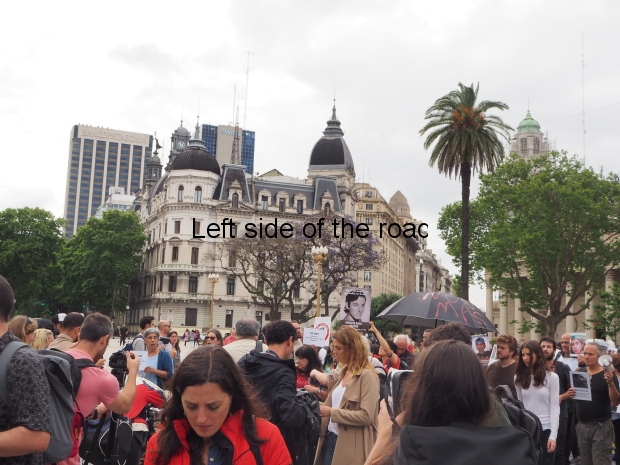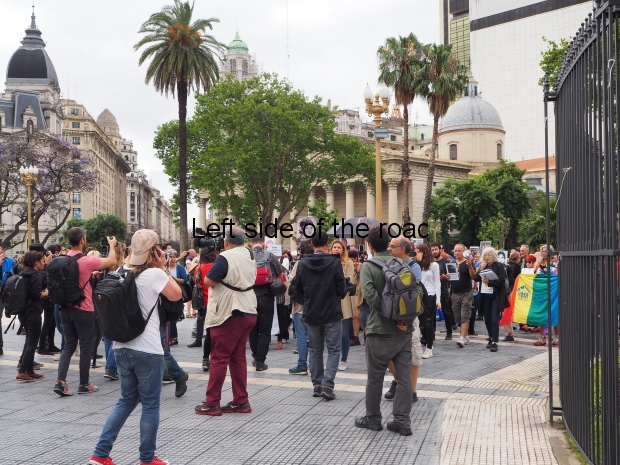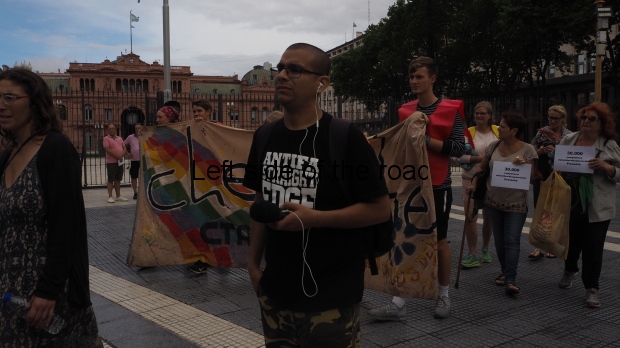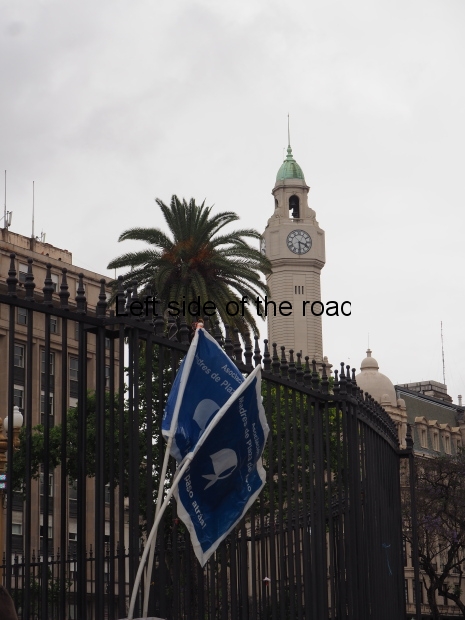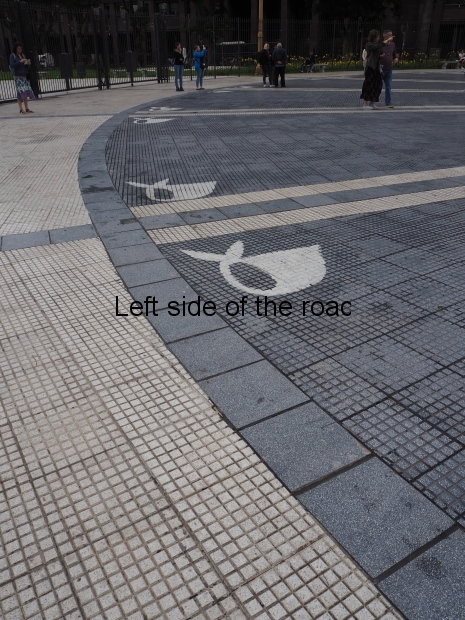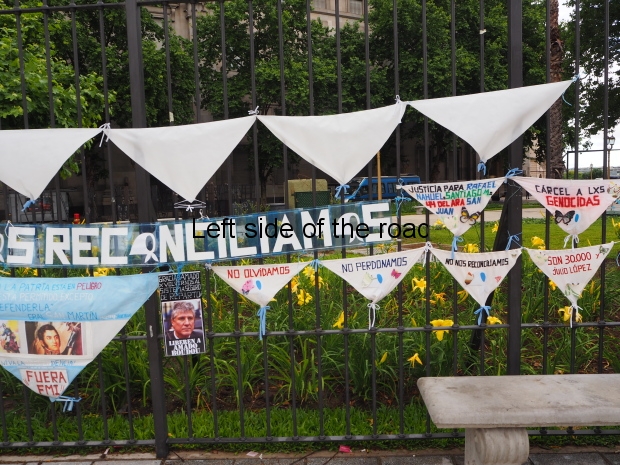
Abuelas de Plaza de Mayo – monthly publication
Abuelas de Plaza de Mayo
People considered to be ‘subversives’ started to ‘disappear’ soon after the military coup of March 1976 in Argentina – known about beforehand and supported subsequently by the government of the United States, especially by the ‘Nobel Peace Prize winner’, Henry Kissinger. Once it was realised that this new regime would rule based upon terror and the elimination of the opposition the mothers of those first ‘desaparecidos’ fearlessly established an organisation – soon to be called the ‘Madres de Plaza de Mayo – Mothers of the Plaza de Mayo’ (from their intention to congregate each Thursday afternoon in the Square of that name, directly in front of the Casa Rosada, the Presidential Palace in Buenos Aires).
Little did they expect that more than 30,000 people would be abducted, tortured and killed by the military in the following seven years. Those mothers also soon learnt that virtually all the young women abducted whilst pregnant would disappear – and so would their babies. In 1977 another organisation was formed, this time called the ‘Abuelas de Plaza de Mayo’ – Grandmothers of the Plaza de Mayo – which sought to reunite those babies with their true families.
Although with slightly different agendas the two organisations have been working together (although at times there have been ideological rifts) ever since and now there have been 2133 (to date) uninterrupted manifestations in the Plaza de Mayo. Thursday 24th January 2019 saw demonstration No 2128.
Without in any way intending to denigrate the determination and steadfastness of these women and their supporters over the decades the presence in the Plaza de Mayo every Thursday afternoon (the march begins at 15.30 on the dot) has been turned into something more than a demand for the whereabouts and fate of the 30,000 ‘disappeared’ and the truth being told about, and to, those babies who were given or sold to those childless supporters of the military in the late 70s.
When just over a dozen women appeared in the square on 30th April 1977 they would have arrived from their homes on public transport and they must have felt very alone as they were faced by the might of the Fascist military in front of their political headquarters, the Casa Rosada. However, this was a situation where the perceived strength of the fascists was outweighed by the moral strength of the mothers’ demands. The Generals looking down from the upper balconies of the Casa Rosada realised that to have crushed this nascent movement would have caused them more trouble than it was worth, not least as the young conscripts would have been able to identify too closely to the protestors. (The first march was on a Saturday, I’ve not yet been able to discover exactly when the Thursday afternoon was selected as the regular day.)
From the very beginning they chose the most simple symbol of their unity – a white head scarf that represented the nappies of their children. This soon became ubiquitous and images to this day can be found throughout the country – see below. The head scarf has also been adapted to show support of other campaigns, especially those concerning women, with a green scarf – with the white design of the Madres in the centre – declaring the person displaying it is openly a supporter of women’s abortion rights which are constantly under challenge in a country with a right-wing, conservative government and where the Catholic Church still wields political influence. At the time of writing there has been a case of an eleven year-old rape victim having to undergo a C-section due to delays in the making of a decision over an abortion.
But now, more than 40 years after starting their protest, the event is much more organised. The Non-Government Organisation (NGO) that the Madres/Abuelas has become has funding now – much of it international – and there’s a van, with the name of the organisation and logo on the side which is used to bring both the people and the equipment needed to provide the spectacle that the Thursday afternoon has become.
There’s a substantial gazebo to provide protection from the elements, as people arrive more than an hour before the 15.30 start time. (In my ignorance when I went to the square on the Thursday before the demonstration against the G-20 summit taking place in Buenos Aires in November 2018 I thought this tent was a last minute addition to protect the Madres/Abuelas from the rain that had fallen heavily that day.) This large tent also houses the loudspeakers and amplification equipment used for the press conference that follows the march around the centre of the Plaza de Mayo. Associated with this is another, smaller tent which houses a temporary bookstall and souvenir table where those who want to learn more about the movements can pick up the increasing number of stories that have been published.
Again, I don’t deny the organisation these facilities but there are problems when a certain amount of money is made available to such popular organisations and working class representatives become ‘celebrities’, some of them being ‘welcomed’ by political and religious leaders, some of whom are from the very class of people who carried out, or condoned the abduction, torture, murder and baby-selling practices that the organisation was originally formed to counter and condemn.
And where there’s money, often a lot, there will be accusations of corruption – which in Argentina are thrown around like confetti and are an everyday news item with accusations and counter-accusations flying around from all sides. Such accusations are being made against the current leadership of the Madres. I have no detailed information about, and have no opinion on, those accusations but suffice it to say that when a lot of money gets involved the opportunists and the jealous will get in their two-penny worth. And however innocent the accused might be mud sticks and the weak and impressionable will remember that more than the 40 plus years of struggle to get answers.
And that 40 plus years is an indictment of Argentinian society, from top to bottom. Various ‘democratic’ governments have ruled in Argentina since the end of the military dictatorship in 1983 – after the generals showed themselves to be totally inept in the prosecution of the military campaign to liberate the Malvinas from British imperialist occupation. But none of them have even got close to answering all the questions that have been asked – more than 30,000 times.
(The Madres/Abuelas have commissioned a video called ‘Todos son mis hijos – They are all our children’ but, so far, I have only been able to locate the trailer. It’s strange that the full documentary isn’t available as the trailer has been out in the public domain since June 2016.)
Whether from an unwillingness to open all the books (due to the fact that they could be tainted by association, or even active participation in the disappearances), reluctance (due to the fact that doing so would open a can of worms and no one could be sure to what other nefarious aspects of Argentinian society such investigations would uncover), fear (due to the fact that until you truly slap down the military and change the whole ideology of the culture they will always hold the threat of another coup over society – this was/is especially the case in neighbouring Chile), or just sheer incompetence and stupidity (which is the norm for most ‘democratic’ politicians who aren’t from the traditional ruling elite) many answers are still not forthcoming. There have been a few trials and many revelations but still many still walk free for their crimes.
In a sense the Thursday event has become part of ‘revolutionary tourism’ with many left visitors to Argentina attending if they are in Buenos Aires that day. Indeed as was I. But that’s not necessarily a negative matter. On my second visit, at the end of January, there were banners condemning the Yankee threat to Venezuela;

Fuera Yankys de America Latina
calling for the closure of the military prison in Callao, Peru, where Presidente Gonzalo, the leader of the Communist Party of Peru (Sendero-Luminoso) has been held since 1993;

Close Callao Military Prison
political prisoners in contemporary Argentina;

Imprisoned for fear, hate, misogyny and racism
against the consequences of ‘austerity’ that is having a devastating effect upon the poorest in Argentinian society;

Wages fall 50%, prices rise by 54%
as well as the ongoing campaign for justice for those murdered in the late 1970s and early 1980s;

Not a step backwards
You can watch and hear what was said at the press conference on Thursday No 2128 on the Madres website but one statement that I thought was interesting is that in Venezuela the army are on the side of the people and not against them as they were in Argentina all those years ago. Events will show how true that statement was.
There are definitely fewer people who are prepared to make an effort to attend the Thursday demonstration but as long as the spark remains it won’t take much for it to become a prairie fire. In all popular movements in Argentina now there is always a reference to the Madres and their struggle, and a handful of their representatives led off the demonstration against the G-20 on 30th November 2018.
For more information:
Asociación Madres de Plaza de Mayo – in Spanish
Here you will be able to watch the press conferences that follow the Thursday afternoon march as well as other material about various activities sponsored by the Association.
There are guided tours, each Wednesday for the general public, in the HQ of the Madres, which is close to the National Congress building in the centre of Buenos Aires. This gives an idea of the what the organisation has done over the last 42 years and also an introduction to some of the successes. These tours have to be booked in advance (and looking on the site it seems that 3 weeks in advance should be sufficient). The tours will predominantly be given in Spanish but there’s a likelihood that the guides would speak English, at least for a translation of certain important points. I didn’t learn about the tours until I left the country so haven’t followed one myself. Any further information would be appreciated.
Abuelas de Plaza de Mayo – in Spanish:
Where digital versions of the publication shown at the head of this post are available (in Spanish).
These give a precise history of the movement, an interesting video asking the question ‘Who are the Abuelas de Plaza de Mayo?’, as well as a list of the babies they have identified as having been kidnapped within hours of their birth and the successes achieved in uniting some of those children with their genetic families.
The ‘stolen’ babies in popular culture
Within a couple of years of the end of the military dictatorship a film took as its subject matter a woman who was unable to bear children adopting a little girl. Although she is depicted as not really wanting to know where the child came from, in 1978 – when the child was supposed to have been born – all within Buenos Aires society, no matter how privileged they might have been would have been aware of the issue. But often people only see what they want to see and disregard the difficult issues. Her husband, on the other hand, knew exactly where the child had come from and was financially, personally and possibly militarily linked with the Fascist regime. His true nature comes out at the end of the film.
The film is ‘La historia oficial – The Official Story’ (1985), directed by Luis Prenzo. Recommended for a view of the situation so soon after the end of the military dictatorship.
‘Madres de Plaza de Mayo’ in other parts of Argentina
I didn’t spend a lot of time in the major cities of Argentina and therefore probably missed locations where the ‘desaparecidos’ were an everyday reality during the 1976-1983 military dictatorship. It would have been in the more industrial and commercial cities where the working class and organised opposition from the academic community would have been more active, and hence more of a target. Patagonia would have been even more isolated in the 1970s than it is now but the 30,000 + subjected to fascist terror are still remembered even in the smaller towns. Often this remembrance was in the form of the white headscarf being painted in a circle around the centre of one of the principal squares of the town – but not always.
In Rio Gallegos in Plaza San Martin:

Madres de Plaza de Mayo – Rio Gallegos
In Bariloche in the Centro Civico. This was slightly different from other places in that here there was a very large of the scarf, names were associated with the various scarf images, as well as the dates they disappeared, and a slogan stating that the murdered would always be with those that remained:

Madres de Plaza de Mayo – Bariloche

Madres de Plaza de Mayo – Bariloche

Madres de Plaza de Mayo – Bariloche
In Ushaia the images were painted on a wall on the main shopping street, San Martin:

Madres de Plaza de Mayo – Ushuaia

Madres de Plaza de Mayo – Ushuaia
In Salta there were small images in Plaza Belgrano:

Madres de Plaza de Mayo – Salta
but there was also a small arch, el Portal de la Memoria, close to the main bus station.

Portal de la Memoria – Salta
and there must be many more which I just didn’t see.



